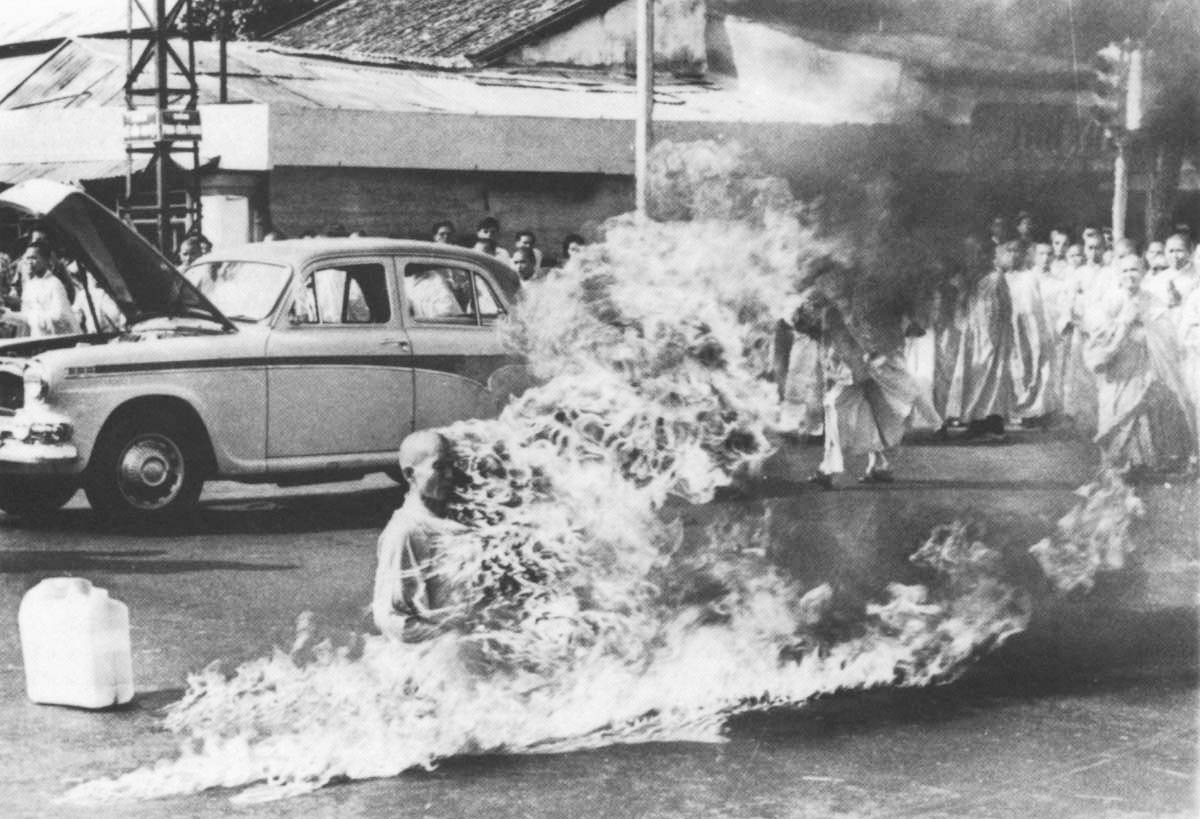ShopDreamUp AI ArtDreamUp
Deviation Actions
Description
Em 11 de junho de 1963, Thich Quang Duc, um monge budista da Pagoda Linh-Mu em Hue, Vietnã, queimou-se à morte em um cruzamento movimentado na baixa Saigon, Vietnã. Ele acendeu a gasolina com um fósforo e se queimou até à morte em questão de minutos. David Halberstam, um repórter do New York Times cobrindo a guerra do Vietnã, deu o seguinte relato:
"Eu poderia ver aquilo de novo, mas uma vez foi o suficiente. Chamas provinham de um ser humano, seu corpo lenta e assoladoramente chamuscando, sua cabeça escurecendo e carbonizando. No ar, o cheiro da queima de carne humana; seres humanos queimam surpreendentemente rá pido. Atrás de mim eu podia ouvir as lamúrias dos vietnamitas que se juntavam. Fiquei muito chocado para chorar, demasiado confuso para tomar notas ou fazer perguntas, perplexo demais até mesmo para pensar. Enquanto ele queimava, jamais moveu um músculo, jamais proferiu um som, sua postura imóvel em flagrante contraste com a trêmula multidão à sua volta ".
Thich Quang Duc tinha se preparado para a auto-imolação através de várias semanas de meditação. Tinha explicado a sua motivação em cartas aos membros da sua comunidade budista, bem como para o governo do Vietnã do Sul nas semanas anteriores. Nessas cartas ele descreveu o seu desejo de atrair a atenção para as políticas repressivas do regime da Diocese Católica que controlava o governo sul-vietnamita naquele momento.
Thich Nhat Hanh explica sobre a razão da auto-imolação de Thich Quang Duc não ser um suicídio, o que é contrário aos ensinamentos budistas:
"A imprensa falou então de suicídio, mas, na essência, não é. Nem sequer é um protesto. O que os monges disseram nas cartas que deixaram antes de se queimarem era destinado apenas a alarmar, a comover os corações dos opressores, e a chamar a atenção do mundo para o então sofrimento dos vietnamitas. Queimar-se pelo fogo é provar que o que alguém está dizendo é da máxima importância. O monge vietnamita, por queimar-se, diz com toda a sua força e determinação que ele pode suportar os maiores sofrimentos para proteger o seu povo. Manifestar-se através da auto-imolação, portanto, não é cometer um ato de destruição, mas realizar um ato de construção, ou seja, sofrer e morrer para o bem de um povo. Isto não é suicídio".
___________________________
On June 11, 1963, Thich Quang Duc, a Buddhist monk from the Linh-Mu Pagoda in Hue, Vietnam, burned himself to death at a busy intersection in downtown Saigon, Vietnam. He ignited the gasoline by lighting a match and burned to death in a matter of minutes. David Halberstam, a reporter for the New York Times covering the war in Vietnam, gave the following account:
"I was to see that sight again, but once was enough. Flames were coming from a human being; his body was slowly withering and shriveling up, his head blackening and charring. In the air was the smell of burning human flesh; human beings burn surprisingly quickly. Behind me I could hear the sobbing of the Vietnamese who were now gathering. I was too shocked to cry, too confused to take notes or ask questions, too bewildered to even think…. As he burned he never moved a muscle, never uttered a sound, his outward composure in sharp contrast to the wailing people around him."
Thich Quang Duc had prepared himself for his self-immolation through several weeks of meditation and had explained his motivation in letters to members of his Buddhist community as well as to the government of South Vietnam in the weeks prior to his self-immolation. In these letters he described his desire to bring attention to the repressive policies of the Catholic Diem regime that controlled the South Vietnamese government at the time.
Thich Nhat Hanh goes on to explaing why Thich Quang Duc’s self-immolation was not a suicide, which is contrary to Buddhist teachings:
"The press spoke then of suicide, but in the essence, it is not. It is not even a protest. What the monks said in the letters they left before burning themselves aimed only at alarming, at moving the hearts of the oppressors, and at calling the attention of the world to the suffering endured then by the Vietnamese. To burn oneself by fire is to prove that what one is saying is of the utmost importance…. The Vietnamese monk, by burning himself, says with all his strength and determination that he can endure the greatest of sufferings to protect his people…. To express will by burning oneself, therefore, is not to commit an act of destruction but to perform an act of construction, that is, to suffer and to die for the sake of one’s people. This is not suicide."
"Eu poderia ver aquilo de novo, mas uma vez foi o suficiente. Chamas provinham de um ser humano, seu corpo lenta e assoladoramente chamuscando, sua cabeça escurecendo e carbonizando. No ar, o cheiro da queima de carne humana; seres humanos queimam surpreendentemente rá pido. Atrás de mim eu podia ouvir as lamúrias dos vietnamitas que se juntavam. Fiquei muito chocado para chorar, demasiado confuso para tomar notas ou fazer perguntas, perplexo demais até mesmo para pensar. Enquanto ele queimava, jamais moveu um músculo, jamais proferiu um som, sua postura imóvel em flagrante contraste com a trêmula multidão à sua volta ".
Thich Quang Duc tinha se preparado para a auto-imolação através de várias semanas de meditação. Tinha explicado a sua motivação em cartas aos membros da sua comunidade budista, bem como para o governo do Vietnã do Sul nas semanas anteriores. Nessas cartas ele descreveu o seu desejo de atrair a atenção para as políticas repressivas do regime da Diocese Católica que controlava o governo sul-vietnamita naquele momento.
Thich Nhat Hanh explica sobre a razão da auto-imolação de Thich Quang Duc não ser um suicídio, o que é contrário aos ensinamentos budistas:
"A imprensa falou então de suicídio, mas, na essência, não é. Nem sequer é um protesto. O que os monges disseram nas cartas que deixaram antes de se queimarem era destinado apenas a alarmar, a comover os corações dos opressores, e a chamar a atenção do mundo para o então sofrimento dos vietnamitas. Queimar-se pelo fogo é provar que o que alguém está dizendo é da máxima importância. O monge vietnamita, por queimar-se, diz com toda a sua força e determinação que ele pode suportar os maiores sofrimentos para proteger o seu povo. Manifestar-se através da auto-imolação, portanto, não é cometer um ato de destruição, mas realizar um ato de construção, ou seja, sofrer e morrer para o bem de um povo. Isto não é suicídio".
___________________________
On June 11, 1963, Thich Quang Duc, a Buddhist monk from the Linh-Mu Pagoda in Hue, Vietnam, burned himself to death at a busy intersection in downtown Saigon, Vietnam. He ignited the gasoline by lighting a match and burned to death in a matter of minutes. David Halberstam, a reporter for the New York Times covering the war in Vietnam, gave the following account:
"I was to see that sight again, but once was enough. Flames were coming from a human being; his body was slowly withering and shriveling up, his head blackening and charring. In the air was the smell of burning human flesh; human beings burn surprisingly quickly. Behind me I could hear the sobbing of the Vietnamese who were now gathering. I was too shocked to cry, too confused to take notes or ask questions, too bewildered to even think…. As he burned he never moved a muscle, never uttered a sound, his outward composure in sharp contrast to the wailing people around him."
Thich Quang Duc had prepared himself for his self-immolation through several weeks of meditation and had explained his motivation in letters to members of his Buddhist community as well as to the government of South Vietnam in the weeks prior to his self-immolation. In these letters he described his desire to bring attention to the repressive policies of the Catholic Diem regime that controlled the South Vietnamese government at the time.
Thich Nhat Hanh goes on to explaing why Thich Quang Duc’s self-immolation was not a suicide, which is contrary to Buddhist teachings:
"The press spoke then of suicide, but in the essence, it is not. It is not even a protest. What the monks said in the letters they left before burning themselves aimed only at alarming, at moving the hearts of the oppressors, and at calling the attention of the world to the suffering endured then by the Vietnamese. To burn oneself by fire is to prove that what one is saying is of the utmost importance…. The Vietnamese monk, by burning himself, says with all his strength and determination that he can endure the greatest of sufferings to protect his people…. To express will by burning oneself, therefore, is not to commit an act of destruction but to perform an act of construction, that is, to suffer and to die for the sake of one’s people. This is not suicide."
Image size
1200x819px 130.75 KB
© 2008 - 2024 Olho
Comments11
Join the community to add your comment. Already a deviant? Log In
This image was one at a historical crossroad - it was probably the first image that would bring the Vietnam situation to the people of the U.S. during the Kennedy Administration, and yet most of us were unaware of our involvement with the Diem regime or Vietnam (a military advisory relationship since the Eisenhower Administration that JFK was continuing, but having doubts about), and it was not the last - but the next major image from Vietnam was of the cold-blooded shooting (through the head) of a captured Viet Cong by a South Vietnamese general. That was in 1966 (if I am not mistaken). By then we were in the quagmire of the Vietnam Nightmare.



































